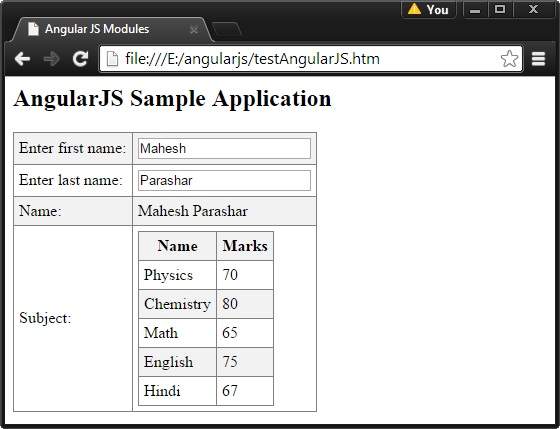AngularJS supports modular approach. Modules are used to separate logic such as services, controllers, application etc. from the code and maintain the code clean. We define modules in separate js files and name them as per the module.js file. In the following example, we are going to create two modules:
- Application Module - used to initialize an application with controller(s).
- Controller Module - used to define the controller.
Application Module
Here is a file named mainApp.js that contains the following code:
var mainApp = angular.module("mainApp", []);
Here, we declare an application mainApp module using angular.module function and pass an empty array to it. This array generally contains dependent modules.
Controller Module
studentController.js
mainApp.controller("studentController", function($scope) {
$scope.student = {
firstName: "Mahesh",
lastName: "Parashar",
fees:500,
subjects:[
{name:'Physics',marks:70},
{name:'Chemistry',marks:80},
{name:'Math',marks:65},
{name:'English',marks:75},
{name:'Hindi',marks:67}
],
fullName: function() {
var studentObject;
studentObject = $scope.student;
return studentObject.firstName + " " + studentObject.lastName;
}
};
});
Here, we declare a controller studentController module using mainApp.controller function.
Use Modules
<div ng-app="mainApp" ng-controller="studentController"> .. <script src="mainApp.js"></script> <script src="studentController.js"></script>
Here, we use application module using ng-app directive, and controller using ng-controller directive. We import the mainApp.js and studentController.js in the main HTML page.
Example
The following example shows use of all the above mentioned modules.
testAngularJS.htm
<html>
<head>
<title>Angular JS Modules</title>
<style>
table, th , td {
border: 1px solid grey;
border-collapse: collapse;
padding: 5px;
}
table tr:nth-child(odd) {
background-color: #f2f2f2;
}
table tr:nth-child(even) {
background-color: #ffffff;
}
</style>
</head>
<body>
<h2>AngularJS Sample Application</h2>
<div ng-app="mainApp" ng-controller="studentController">
<table border="0">
<tr><td>Enter first name:</td><td><input type="text" ng-model="student.firstName"></td></tr>
<tr><td>Enter last name: </td><td><input type="text" ng-model="student.lastName"></td></tr>
<tr><td>Name: </td><td>{{student.fullName()}}</td></tr>
<tr><td>Subject:</td><td>
<table>
<tr>
<th>Name</th>
<th>Marks</th>
</tr>
<tr ng-repeat="subject in student.subjects">
<td>{{ subject.name }}</td>
<td>{{ subject.marks }}</td>
</tr>
</table>
</td></tr>
</table>
</div>
<script src="http://ajax.googleapis.com/ajax/libs/angularjs/1.2.15/angular.min.js"></script>
<script src="mainApp.js"></script>
<script src="studentController.js"></script>
</body>
</html>
mainApp.js
var mainApp = angular.module("mainApp", []);
studentController.js
mainApp.controller("studentController", function($scope) {
$scope.student = {
firstName: "Mahesh",
lastName: "Parashar",
fees:500,
subjects:[
{name:'Physics',marks:70},
{name:'Chemistry',marks:80},
{name:'Math',marks:65},
{name:'English',marks:75},
{name:'Hindi',marks:67}
],
fullName: function() {
var studentObject;
studentObject = $scope.student;
return studentObject.firstName + " " + studentObject.lastName;
}
};
});
Output
Open the file textAngularJS.htm in a web browser. See the result.



No comments:
Post a Comment